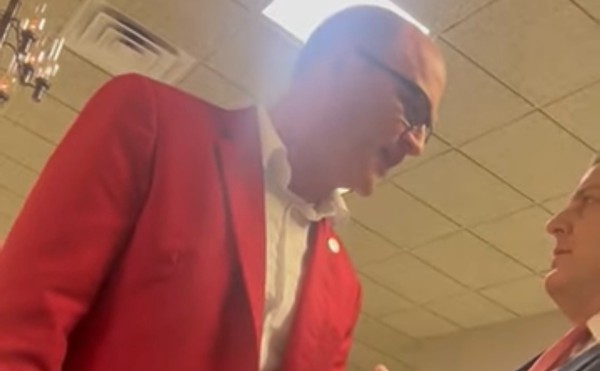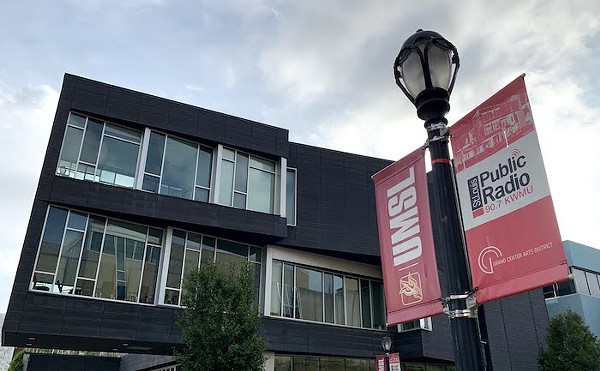A well-to-do twentysomething with roots in Florida, Lazarus was excited at the prospect of her maiden voyage on Amtrak, even though it would have been a far swifter schlepp on a jet. Expecting something akin to the wood panels and red-velvet décor depicted on Hollywood celluloid, Lazarus was let down by the Eagle's comparatively bland design scheme -- a somber mood that, coupled with a vicious hangover, caused Lazarus to drown her sorrows in cheap red wine in the bar car for the entire six-hour trip to St. Louis.
But it wasn't until Lazarus took a gander at St. Louis' sorry excuse for an Amtrak station that the tears started flowing. The landlocked heartland can be depressing enough for a child of the coast, but when said Amtrak station is a stapled-together double-wide trailer in a dingy, muddy section of America's most dangerous city, the emotions can descend to near-clinical depths.
As evidenced by a chorus of "Are you kidding?" utterances from her fellow passengers, Lazarus wasn't the only one taken aback by the city's infamous "Amshack," a temporary facility with an intended shelf life of three years, erected when Amtrak pulled out of Union Station in 1978. It is, according to rail-association members and local officials, easily the most embarrassingly pathetic big-city railroad station in the country, something that could not have made the most positive impression on the 130,610 passengers who passed through its narrow glass doors from October 1, 2001, to September 30, 2002.
"It's a piece of crap," says Tom Shrout, a Central West End resident and MetroLink user who leads the St. Louis-based Citizens for Modern Transit. "You don't even have to compare it with big cities'. Kirkwood's got a better station; Washington (Missouri) has a better station; Irvine, California, has a better station."
"When I have friends who come to visit by train, I have to apologize in advance," says local radio personality Bob Hamilton, who lives in the city's picturesque Lafayette Square neighborhood.
For almost a quarter-century, replacing the Amshack has been St. Louis' lowest-prioritized political hot potato, treated like the teenage foster child everyone is nice to but no one wants to care for long-term. First conceptualized as a $45 million "multimodal" transportation center at the corner of Jefferson and Scott avenues that would house buses, trains and a heliport, an Amshack replacement has been on the books for four administrations, from Vince Schoemehl to Francis Slay.
"There's been a less-than-genuine commitment on the part of previous administrations," says East-West Gateway Coordinating Council executive director Les Sterman. "It's sort of a testimony to the bureaucracy of the city and its ability to manage a complex project."
Or the lack thereof. But although Sterman and CMT's Shrout maintain an "I'll believe it when I see it" posture, even the city's most ardent critics see cause for optimism -- embodied by proven civic achiever John Roach, Slay's designated Amshack-replacement point man.
To support their enthusiasm, Sterman and Shrout note Roach's leadership in the Skinker-DeBaliviere neighborhood revitalization project and the MetroLink extension into St. Clair County, Illinois.
"Roach has a track record," says Shrout. "When they turned this project over to him, I was delighted."
Amshack's primary problems have centered on money and priorities. To address the former, Roach and Barb Geisman, Slay's deputy mayor for development, have whittled the project's budget down to a more realistic $25 million and hope to break ground this spring. Their goal: to complete a multiuse station -- dubbed the Intermodal Transportation Center -- right next to the Savvis Center MetroLink stop by the end of 2004.
"The problem was, the prior administration had lofty visions for what they wanted," says Downtown Now! Executive Director Tom Reeves of the early proposals. "They were looking at a $45 million project -- and they had half that. John and Barb said, 'We don't need a heliport and all this crap.' They sat down and trimmed it down, and they're moving ahead with it."
And not a moment too soon; the Chicago-St. Louis run is the pilot corridor for Amtrak's Midwest Regional Rail Initiative, which will feature high-speed trains that could double the number of trips between the two cities and reduce travel time by nearly two hours before the end of next year. Should Slay, Roach and the Amshack's other stakeholders fail to meet their latest construction deadline, St. Louis' dirty little double-wide secret could mushroom into a very public reminder to visitors -- most notably, Chicagoans -- that St. Louis' urban core, in its current form, is positively bush-league.
In fairness, as Roach notes, funding Amshack's replacement isn't the sole responsibility of the city.
"It's like stone soup," says Roach. "There's a federal appropriation, FTA [Federal Transit Administration] bus money, a planning grant from East-West Gateway and federal highway money from MoDOT [Missouri Department of Transportation], and then there's a city match for the federal appropriation."
That said, the city is the project's main engine in terms of execution, says former Mayor Freeman Bosley Jr. The Boz offers a slew of seemingly strong excuses for why his administration failed to make much, if any, headway on the replacement station's development.
"When we first came into office, we were fighting the [April 1993] flood; then we're faced with airport expansion and TWA's bankruptcy -- you just had stuff popping off all over the place," says Bosley. "And the city's broke. Plus, we were building a stadium without a football team. Multimodal was not in the top five."
Being low man on the totem pole is a familiar spot for Amtrak, a federally mandated, heavily subsidized national rail system that was put into place in 1971 after America's private passenger-rail industry essentially threw in the towel, fiscally scorched by ever-cheaper airfares and the public's preference to drive or fly rather than ride the rails. Almost immediately, the agency began huffing and puffing about Union Station's inadequacy because it required trains to pull in and back out, an inconvenience that Amtrak was willing to overlook in bustling ports such as Chicago and Washington, D.C., but not in St. Louis.
"Amtrak didn't want to back into Union Station; they wanted to pull through," says Shrout.
From the get-go, Amtrak "has always been the stepchild," says American Association of Railroaders president Rich Eichhorst, a perception he chalks up to a widespread congressional expectation that the system will one day return to its privatized roots.
"It's been a political football," says Eichhorst, a retired Hazelwood East High School social-studies teacher whose group of choo-choo aficionados is based in St. Louis. "On September 12 [the day after the 2001 terrorist attacks], the airlines can be in D.C. asking for millions and they get it, whereas for Amtrak, it's 'Oh, sorry.'"
Says Shrout: "The margins on Amtrak's operations are so tight. You squabble over $1.2 billion every year, while airlines are bailed out to the tune of billions of dollars."
Lately this struggle has gotten decidedly cutthroat, with Amtrak chief David Gunn threatening to shut the entire rail system down before prying the money from Congress. Still, as Hank Dittmar, executive director of Reconnecting America -- a Washington, D.C., think tank devoted to reviving rail service as a complement to roads and airports -- noted in a December 30 Washington Post op-ed piece that the annual appropriation "doesn't begin to pay the cost of railroad retirement, deferred maintenance and capital costs." Hence Amtrak is forced to rely heavily on partnerships with state and municipal governments to come up with the necessary dollars to keep its trains a-chuggin'.
But even operating dollars are difficult to scrounge up, as evidenced by the current conundrum in the Missouri Legislature over a $1.2 million supplemental budget request -- backed by Governor Bob Holden and MoDOT -- that would ensure that the number of Amtrak runs among St. Louis, Jefferson City and Kansas City are not cut from two round trips a day to one. Sharon Dashtaki, assistant administrator of railroads for MoDOT, says she's somewhat nervous about the extra appropriation's chances in the state capitol.
To hear state Senator Jon Dolan (R-2nd District), chairman of the transportation committee, tell it, she should be.
"MoDOT dropped a bit of a bombshell," says Dolan, who is quick to point out that he is not necessarily opposed to the supplemental request. "They didn't know money from last year was so tight. I grew up with mass transit, and I certainly understand how important it is. However, there are some tough decisions around the corner. If we need to reduce the schedule to one train, I think we can live."
Funding difficulties and all, Shrout is a true believer in the viability of improved rail service and facilities for St. Louis, drawing up technological and economic examples both home and abroad to slam home his points.
"Obviously the technology's there in Europe and Japan," adds Shrout. "Some trains in France run over 200 mph. The thing with train travel is, it brings people to the central city. Airports don't. Just as Washington Avenue and [the proposed] Ballpark Village are strategies for making downtown a better place, trains reinforce it as a destination."
None of these shimmering visions will coalesce properly, however, unless the Amshack is replaced with a permanent structure. As Bosley points out: "Somebody should have spiked the ball by now."
Eichhorst jokes about a security-related silver lining in failure.
"With so much concern over homeland security, we'd say, 'Keep the Amshack," he quips, "because every self-respecting terrorist would see the Amshack and think that the real station must be somewhere else."
That's funny, in a twisted sort of way. What is entirely devoid of humor is the fact that, after nearly 25 years, St. Louis' "temporary" Amshack is still standing.





